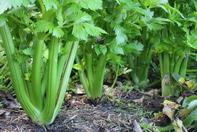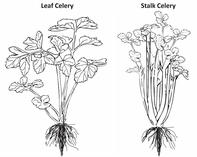
Plant Description
Celery belongs to the Apiaceae family and is related to parsley, parsnips, coriander and carrots. It originates in the Mediterranean region. It is a biennial plant but for fresh production it is planted and harvested as an annual.
The plant develops from a bulbous base or heart at ground level into the bunch of stalks or petioles of the plant that end with a bush of fine tender leaves. The petioles or stalks of the leaves are the main edible section of the celery.
Celery plants are normally harvested when they are about 40 to 50 cm high. The celery root system is made up of a taproot with a mass of fine fibrous roots in the top 20 cm below the surface. It normally produces its flowers and seeds in the second year.
Uses
Celery is mostly used for flavouring in soups and stews. It is also eaten raw and in salads or cooked as a vegetable. The celery plant does not have many vitamins or nutrients and is low in carbohydrates.
It is mostly made up of fibre and water so is favoured by people intent on losing weight. The celery seeds are ground and used in salt and they contain oil that is used in perfume and as a medicine, which aids in the break down uric acid in the blood for the treatment of gout, arthritis and rheumatism.
Soil Requirements and Preparation
Celery does best in well-drained, sandy loam soils with adequate organic material for moisture and nutrient retention. It requires a slightly acid soil with a pH of 6.0 to 6.5. Six weeks before planting, plough and rip the area to be planted down to at least 500 mm.
At this time incorporate lime if required as well as or any compost, manure, gypsum and superphosphates. If a green cover crop had previously been sown, this is cut down and ploughed into the soil at the same time.
One week before planting celery, plough the land and disk harrow to level and prepare the area. This also gets rid of any weeds that are taking hold. The seed beds must be clean and loose without soil clods or any weed or vegetative debris in the topsoil that will hamper root development.
Climate
Celery requires a cool climate with no frost and with temperatures of 15°C to 24°C. When there are prolonged periods of temperatures above 25°C during the growing period it makes the celery more bitter and fibrous.Cultivars
